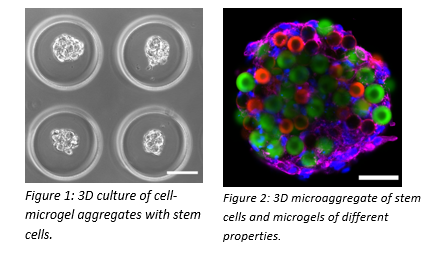Microfluidic production of degradable microgels for advanced living microtissues
AIM
Design and optimize microgels with degradable properties to advance 3D cell culture of stem cell spheroids.
INTRODUCTION
Culturing cells in aggregates is a very efficient approach to study their interactions in a natural 3D environment. However, guiding cell behavior in cellular microtissues remains a grand challenge. We hypothesize that artificial cells made from small hydrogel beads (i.e., microgels) could play a significant role in gaining more control over, and deeper understanding of, cellular behavior. Indeed, our group has recently introduced this ground breaking technologies and has demonstrated the potential of this exciting approach. However, the use of such microgels could hinder the natural development of the tissue e.g., by being physically in the way of tissue (de)formation. Consequently, the development of a degradable microgel approach is anticipated as a highly desirable feat that would allow us to steer cell fate, while not imposing material-based hinderance on tissue formation.
Recently, our group has developed a microfluidic platform to produce smart, cell-sized, and cell-adhesive microgels that self-incorporate in stem cell microtissues. These microgels offer a high level of control over their physical and chemical properties, which was leveraged to tune stem cell behavior within cell-microgel aggregates (Figure 1 and 2). However, clinical translation of these microgels is hindered by the exceedingly slow degradability of the currently used microgels. To improve microgel function and facilitate clinical translation, we aim to develop a degradable microgel that can still steer the behaviour of stem cells, while being degradable when placed in the body.
In this project, the student will optimize the engineering of a degradable microgel on a microfluidic system. Moreover, the student will investigate the use of these degradable microgels in 3D stem cell culture. For example, the microgels will be functionalized with various cell-adhesion mimicking peptides and optimized for tuning their mechanical properties over time. Specifically, the effect of these degradable microgels on hMSC behaviour (e.g., viability, differentiation) will be investigated.

GOALS
1. Produce cell-sized microgels using an advanced droplet microfluidic system
2. Functionalize microgels with biofunctional moieties
3. Combine microgels with stem cells in 3D co-cultures
4. Steer and evaluate the behaviour in 3D stem cell aggregates
TECHNIQUES
The student will learn several state-of-the art techniques, including droplet microfluidics, enzymatic hydrogel crosslinking, (3D) stem cell culture, qPCR, immunohistochemistry, and confocal fluorescence imaging and apply this skill set in a top-level institute.
RELEVANT LITERATURE
1. Kamperman, T., Microgel Technology to Advance Modular Tissue Engineering, in Developmental
BioEngineering. 2018, University of Twente. p. 174.
2. Barcelona-Estaje, E., Dalby, M. J., Cantini, M., Salmeron-Sanchez, M., You Talking to Me?
Cadherin and Integrin Crosstalk in Biomaterial Design. Adv. Healthcare Mater. 2021, 10,
2002048
3. Kamperman, T., Koerselman, M., Kelder, C. et al. Spatiotemporal material functionalization
via competitive supramolecular complexation of avidin and biotin analogs. Nat Commun 10,
4347 (2019)
